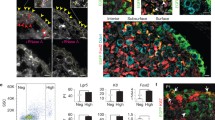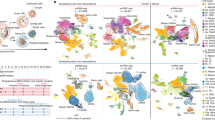Abstract
Expression of the cell adhesion molecule E-cadherin in the developing mouse has been investigated by immunocytochemistry and disaggregated organ culture. The principal aims were firstly, to determine whether E-cadherin is expressed in the indifferent gonad and if so with which cell population(s) it is associated. Secondly, to investigate the pattern of expression in the mesonephros, especially in relation to ventral mesonephric tubule cells, which contribute to the somatic cell population of the gonad. Thirdly, to discover whether there are any sex differences in expression of E-cadherin in differentiating gonads. Germ cells in the indifferent gonad showed strong immunoreactivity whereas somatic cells were unstained unless their membranes were in contact with those of germ cells. Positive staining for E-cadherin was found in epithelial cells of the mesonephric duct and tubules. Staining was weak at the ventral margins of the ventral mesonephric tubules. At later stages, germ cell immunoreactivity could be correlated with stages of ovarian differentiation, being reduced or absent between germ cells at 16 days post coitum, when ovigerous cords become dissociated as a prelude to follicle formation. Stronger staining reappeared briefly at 17 days post coitum, the time of follicular cell attachment to oocytes, before waning again 2 days later. Similarly, immunoreactivity in the differentiating testis was initially restricted to the germ cell population but pre-Sertoli cells were strongly positive between 16 and 19 days post coitum. The most striking sex difference was seen in the somatic cell population, where Leydig cells of the testis became strongly positive for E-cadherin from 17 days post coitum onwards. At this time, unlike controls, dissociated cells from gonads of either sex were unable to reform their initial contacts when cultured in the presence of the antibody to E-cadherin, confirming its functional importance.
Similar content being viewed by others
Author information
Authors and Affiliations
Additional information
Accepted: 9 December 1998
Rights and permissions
About this article
Cite this article
Mackay, S., Nicholson, C., Lewis, S. et al. E-cadherin in the developing mouse gonad. Anat Embryol 200, 91–102 (1999). https://doi.org/10.1007/s004290050263
Issue Date:
DOI: https://doi.org/10.1007/s004290050263




